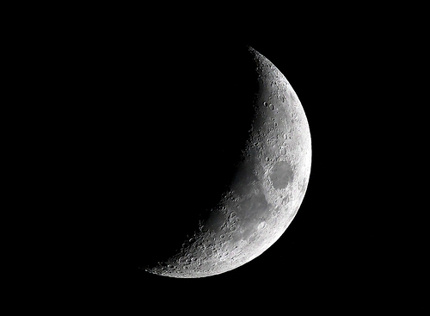
The young moon returns
In June 2021, new moon happens on June 10 at 10:21 UTC. And so – by about June 11 – the young moon, a waxing crescent, returns to the evening sky. If you watch that evening, and in the evenings after that, you can also notice two planets, Venus and Mars.
You can spot Regulus, Heart of the Lion in the constellation Leo, now about to descend into the sun’s glare for another season. And you might also glimpse the stars Castor and Pollux in the constellation Gemini the Twins. They’re in such bright twilight, though, that they’ll be tough to see.
Evening of June 11, 2021
For us in North America, the moon turned new during the early morning hours of June 10. That means – for us in North America – the moon will be well over one day (24 hours) old at sunset June 11, staying out for over one hour after sunset. On June 11, the sleek and slender young moon will be pairing up with the dazzling planet Venus on the sky’s dome.

That’s not to say that moon watchers in the world’s Eastern Hemisphere won’t see the young moon after sunset June 11. But the younger and thinner moon may present more of a challenge, as an even paler crescent sets all the sooner after sunset.
Find out when the moon sets in the U.S. or Canada via Old Farmer’s Almanac
Find out when the moon sets anywhere virtually worldwide via Sunrise Sunset Calendars
No matter where you live worldwide, it’ll be to your advantage to find an unobstructed horizon in the direction of sunset on June 11, if you want to see the young moon. And find a hill or balcony to stand on, if you can. The extra height above ground will help you spot it. Binoculars come in handy for any young moon hunt.
Evening of June 12 and 13
Don’t fret if you miss the moon and/or Venus after sunset June 11. Try again on June 12 and 13, remembering that the illuminated side of the moon will be pointing toward Venus on the sky’s dome.
On June 12 and 13, you can use the moon and Venus to help you find the planet Mars. After all, the moon and Venus rank as the second-brightest and third-brightest celestial bodies in the sky, respectively, after the sun. Likely, you might have to wait until nightfall, and possibly after Venus sets, to see Mars. The red planet is now relatively dim and inconspicuous, especially in contrast to Mars in late 2020. Earth has flown ahead of Mars in the race of the planets. Mars is far across the solar system from us now. Thus Mars appears dimmer, to our eyes. Watch for it near Sunday evening’s moon.
Also watch for two bright stars in Mars’ vicinity. They’re the Gemini stars, not really twins, but known as twins in skylore, Castor and Pollux. Pollux is the brighter Gemini star. It’s about 1.8 times brighter than Mars, yet some 100 times fainter than Venus.
Above Venus and Mars in the west after sunset – along the ecliptic, or path the sun and moon travel – notice the bright star Regulus. This star is known as the Lion’s Heart. It’s in the constellation Leo the Lion. As seen from the Americas (and as shown on our chart at top), the moon will be nearest Regulus around June 15.

Don’t forget to watch for earthshine
Around mid-June 2021, day by day, more and more of the moon’s daytime half will appear turned in Earth’s direction. Thus we’ll see a waxing moon in our sky, a wider and brighter lunar crescent. On these evenings, see if you can catch earthshine – twice-reflected sunlight – softly illuminating the nighttime side of the moon.
Also notice the lunar terminator, the line separating the moon’s daytime and nighttime sides. It shows you where it’s sunrise on the waxing moon. If you’re using an optical aid like binoculars or a small telescope, notice that it’s along the terminator that you’ll see the best 3-dimensional views of the lunar terrain. That’s because – just as at an earthly sunrise – the shadows are longer.

Bottom line: On June 11, 12 and 13, 2021, watch for the young moon to return to the evening sky. As viewed from North America, the slender crescent pairs up with Venus on June 11 and Mars on June 13. Enjoy!











